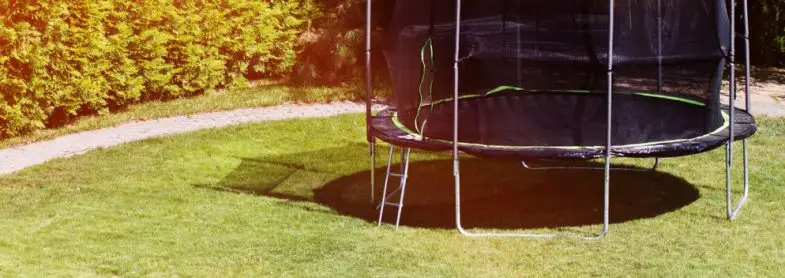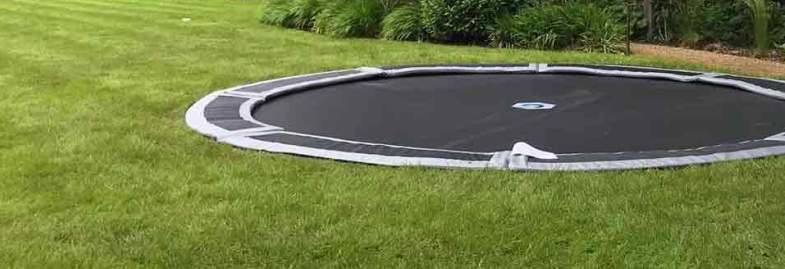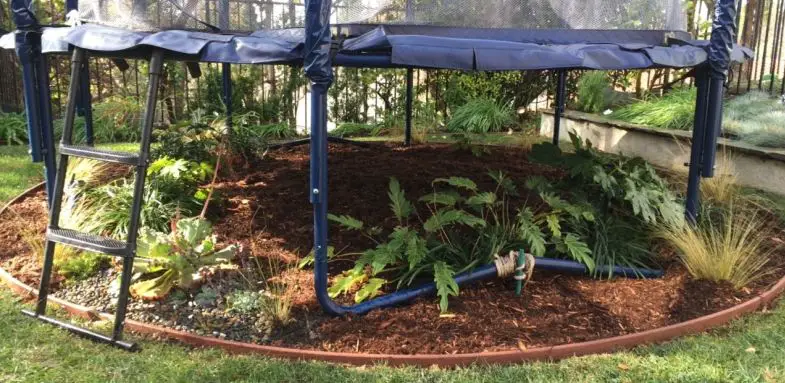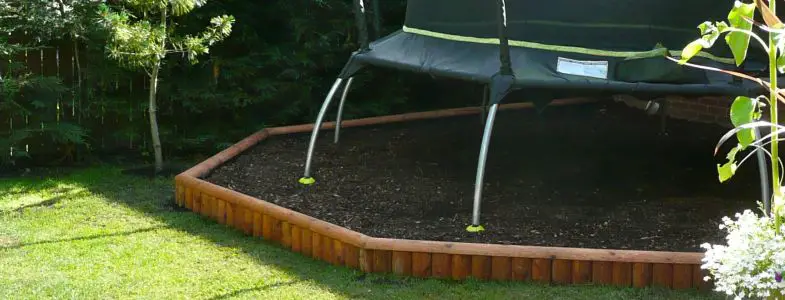It’s important to consider your surrounding environment and your landscaping options when choosing a location to place your trampoline. Obviously you need to think about the existing location of nearby trees & large shrubs and how much open space you are going to need around your new trampoline, but the foundation for the trampoline shouldn’t be glazed over.
You will have to decide what you’ll be placing under your trampoline if anything at all.
Many people just place their trampoline right in the middle of their backyard, right on top of the grass without giving any thought to ground leveling, supports sinking into the ground, or the potential damage the trampoline can and will cause to existing turf and any nearby landscaping.
If you’re having trouble figuring out what the best landscaping options are for the placement of your trampoline then you’ve come to the right place. We’re going to break down everything you need to know about trampoline placement and what to put in the space underneath it.
So…What Should You Put Under Your Trampoline?
At first thought, it seems that grass is the best place to plop a trampoline. There are many alternatives to this and they are worth exploring if you care about having options.
In the best of all worlds you would choose a location for your trampoline that is already flat.
You would then remove the grass that would be under and around the trampoline (most large trampolines will either kill the grass anyway or be nearly impossible to maintain) and then set the trampoline’s legs on sturdy supports like concrete which will not sink, migrate, or crack.
Then around the supports, under the trampoline, and around the trampoline where the grass was removed you would add a thick layer of mulch to act as a safety mat and as a way to suppress vegetation like weeds and wrap the whole area in a beveled rubber-style edging product, kind of like this one I’ve been looking on Amazon’s site.
If it was in my backyard I would then pull my woodworking tools out from the garage and build an under trampoline storage box that would circle the diameter of the trampoline but not extend under it to the middle. Under the springs the trampoline will not sink far enough to hit a thin storage box but it would if you extended it towards the middle of the jumping mat.
For me I think the space is usable and this step is worth the effort but for others this might be an unnecessary step. Many will just extend mulch all the way under the trampoline while those with a green thumb may even plant an ornamental garden under the frame to add some decorative appeal to a space that would be otherwise devoid of grass, greenery, or flowers.
Do Trampolines Have to Be on Grass?

Level grass offers a great space that is both soft and sturdy. While grass is considered to be the most convenient and ideal place to put a trampoline, it is definitely not a requirement.
Some drawbacks of placing a trampoline on grass include dying grass, a formation of mud which gets the frame dirty, and the legs sinking into the dirt. Soil that becomes softened by the weight of a trampoline can cause sinking that results in your trampoline becoming lopsided – which is a big danger.
In many cases, grassy yards are an uneven and unsafe location for your trampoline. That being said, it is possible to create an even space for your trampoline by digging out an area and replanting the dirt and grass to be even.
Sunken Trampolines Are Another Option But Installing Them Can be Pricey

A unique way to avoid the dangers of your trampoline becoming lopsided is by investing in a sunken trampoline. Sunken trampolines are placed partially underneath the ground so the jumping surface is at ground level.
Sunken trampolines offer several benefits that may be appealing to you. They include increased stability, lower chance of falling & injury, as well as taking up less space in your yard. These trampolines can be covered with something known as a grass lid, totally removing it from sight.
It’s important to keep in mind that the process of building a sunken trampoline can be quite expensive. You will also need to take a lot of time determining where you would like to place it so you don’t end up regretting its location.
Will Grass Grow Under a Trampoline?
Grass may or may not grow under your trampoline. This all really depends on the type of grass you have, the weather and season in your geographic location, the weight of your trampoline, and other various factors like sprinkler placement, etc.
The most common outcome is that grass will suffer from being too dry, not getting enough sun and the weight of the trampoline. If you have a spacious yard that is generally level, then a way around this is to move your trampoline around regularly to avoid this.
Some people report experiences of grass growing well in the area underneath their trampoline. If this is the case, then you’ll need to maintain the grass in this spot more often.
Can You Put Fake Grass Under a Trampoline?
Wondering about putting fake grass under your trampoline? You’ll be happy to know that this is a great alternative so you won’t have to worry about maintaining real grass. There are many manufacturers that create grass mats specifically to place under your trampolines.
Fake grass is also a great option if your yard is not the typical environment for grass to grow. The synthetic grass will serve as a plush area that looks great and serves as protection for your trampolines frame from hard surfaces like concrete.
Other Trampoline Base Ideas: Alternatives to Grass

An alternative to placing your trampoline on grass is by installing a base of organic materials. You can use wood chips, sand, or mulch to provide your trampoline with a stable, soft surface. They are also soft landings that will absorb impact.
This is a great place to put that rubber mulch frequently used in children’s playgrounds because not only will it suppress weeds and vegetation but it will be softer and bouncier and can help in minimizing injury if someone were to fall off the trampoline.
The way this organic base is made is by digging up a 10-12 foot deep trench that reaches out 4-6 feet out from your trampoline. This should be consistent all the way around the trampoline perimeter and the perimeter radius will be dependent on the overall size of your trampoline diameter.
The base of the trench at the feet of your trampoline is where you will build the hard supports for the legs which will aid in stability over the years but the stable base should only sit below the legs and frame. The rest of the space should be lined with weed cloth and sand and then topped with a very thick layer of mulch.
You can fill the remainder of the trench with the material of your choice and most people will finish the project off by installing a clean edging around the perimeter to keep the mulch material in place and to give the project a “finished” look.
Can You Put a Trampoline on Gravel?
Placing your trampoline on gravel is a great option that requires little effort in terms of maintenance. If you do decide to put your trampoline over gravel, then you’ll need to place some sort of soft matting for the entrance and perimeter because although gravel will suppress weeds from growing under the jump surface it won’t feel good if you fall on it.
It is recommended that you have a protective netting or cage around your trampoline when placing it over gravel because the gravel will cause injuries if anyone falls into it.
Can a Trampoline Be Placed on Concrete?
If you are wondering if you can place a trampoline on concrete, the answer is, unfortunately, no – unless the concrete pad is built for your specific trampoline.
If you want to devote the time, money, and energy to installing a concrete base in the shape of your trampoline to set it on without building it wider than the actual trampoline then you will find this to be a very sturdy and level option.
You should still build out a perimeter around your trampoline for the installation of padded rubber mulch and it would be best to extend the mulch over the entire surface of the concrete pad to prevent injury that could occur of someone were to fall off the edge or through the springs.
Obviously the main reason it isn’t recommended to put a trampoline on concrete is the fact that it’s a dangerous surface for jumpers to fall onto. Even if your trampoline has a protective cage, there is still a possibility of falling and a huge concrete surface like a driveway or patio will cause injury.
Another negative is the stress on the frame from its impact on the concrete over time. This results in parts of the trampoline wearing out quicker and eventually breaking.
If you don’t have any other options than to place your trampoline over concrete, it is essential to place some sort of rubber padding on the feet of your trampoline and a large soft pad for protection. A few options include rubber gym flooring mats and foam interlocking tiles.
While these things come at an additional cost, it is more than worth the price taking into consideration safety and longevity. It is also important to understand that many trampoline manufacturer warranties are considered void when you use their trampoline on concrete without any form of protection.
Additional Things to Consider in Terms of the Landscaping Surrounding Your Trampoline
Aside from determining what you can put under your trampoline, it’s also essential to understand the basics of the landscaping surrounding it. From the correct safety measures to pleasing aesthetics, there are many things you can do to create a nice environment for your trampoline.
Safety
When it comes to kids and trampolines, the number one concern parents have is the safety of their kids. It’s not difficult to take the necessary measures in order to ensure your trampoline is safe to use & offers a delightful abode for them to have fun.
Ensuring the Ground is Level
No matter what type of ground you’ll be placing your trampoline on, it is of utmost importance that it’s leveled. Even slight tipping & small hills underneath your trampoline can pose potential danger.
The legs of your trampoline should be level and still. If there is any type of rocking, this will indicate that the ground is not level. A surface can be leveled by digging or being built up.
Trees in the Surrounding Area
If there are any trees that hang over the trampoline, they will need to be trimmed. Low branches can cause head injuries, even if you believe they are too high to reach. Another potential threat is falling branches.
You should especially avoid trees bearing fruit or nuts. As a general rule, it’s best to place trampolines as far away from trees as possible.
Landscaping and Aesthetic
Shrubs & Plants
To help create the feeling of a separate recreation area, you can plant hedges at a safe distance around. This not only provides some privacy, but it also reduces sounds from your yard and acts as a wind buffer.
Additional plants such as flowers can be planted around the trampoline for pleasant border garden. Some species of plants are able to grow under your trampoline as long as they don’t grow high. Plants that would work for this include lamium, odorata, or pulmonaria among others.
Pathway
A pathway can be created to create a great aesthetic in your yard. Consider using cobblestone, stepping stones, or pavement for this. Include other areas of your yard along the pathway, such as a swing-set, pool, or benches to allow the path to bring everything together.
Here Are a Few Workarounds and Alternative Ideas for the Space Under Your Trampoline
In this section I’ll cover the following bonus ideas:
- Force the Grass to Grow Under the Trampoline
- Install a Special Under Trampoline Mat
- Build a Wall Around the Perimeter of Your Frame
- Plant Non-Grass Shade-Loving Plants as a Ground Cover Under Your Trampoline
- Install a Circular Sandbox Around Your Trampoline Instead of Using Mulch
If I were to install a mat under the trampoline I would probably opt for a playground style interlocking rubber mat like this one I found on Amazon because they are meant to soften falls from kids on playground equipment… but even still I like the idea of building storage under the trampoline or planting a ground-cover garden.
How to Get The Grass to Grow Under a Trampoline
There are two main reasons why grass will die under a trampoline.
- First light is blocked by the jumping mat and most grasses don’t like that so much.
- Second, the jumping mats don’t let enough water get to the turf underneath so if you get rain or your sprinkler is dropping water on the mat it just doesn’t get to the grass underneath.
A third reason that grass dies under a trampoline is related to the water. In the middle of summer when temps are their hottest the jumping mat actually radiates more heat down to the soil and grass underneath and kills it off faster since it’s already stressed due to low light and water.
In the early Spring most of these problems are moot because there’s usually ample moisture through the winter to permeate through the ground under the trampoline when heat and sun and evaporation is at their lowest points of the year.
The radiating heat from the mat actually helps to raise soil temps underneath faster and this can kick-start grass growth early in the Spring only to falter as Spring starts pushing towards summer and temperatures start increasing a lot.
If you want to grow grass under a trampoline then the best practice is to put that trampoline in an area where you can rotate it’s placement on the lawn every 2-3 weeks. In the fall you should be actively overseeding with grass that is drought and/or shade tolerant and you should also be taking time every week to water underneath the trampoline mat unless you have a sprinkler head that can get water under it automatically.
One of the best grass types for heavy shade are any variety of fescue.
Overseed with it every autumn and fertilize it so that you promote as much root growth as possible, even at the expense of top growth, and line the base of your trampoline with reflective decor so that small amounts of sun can make it underneath.
Lastly, mow under the trampoline often to stimulate root development but keep the grass tall to improve the chances of blades catching sunlight for photosynthesis. You’ll still have to move the trampoline occasionally to keep the grass healthy but at least these measures will give the lawn area a fighting chance.
Are Under Trampoline Mats Worth It?
I’m a firm believer in using the space under a trampoline rather than covering it up with a a mat of artificial turf. In most cases you have to prepare the ground underneath for a good installation of a mat anyway so you might as well prepare the grounds for a garden, storage, or to be blocked off entirely.
When you have a regular lawn or a nice mat sitting under a trampoline the temptation is too great for kids to go under it and get injured which is why I’m an advocate for thick shade-loving ground cover or larger shade-loving decorative plants like a ring of hostas.
If you were to put a mat under your trampoline this would help with keeping the area under and around your trampoline looking good but it’s just not as safe as planting a long term deterrent like a dense landscape of low to to the ground shrubs that don’t require much light.
How to Close Off the Space Under Your Trampoline
In my yard I don’t have enough flat space to dedicate a full size trampoline. I love on 1.5 aces but a lot of it is hilly and I only have a small section of flat lawn that I don’t want to give up.
If I did however I would be quick to build a wooden wall to fit under the frame of the trampoline wrapping all the way around the circumference so that my children didn’t go underneath.
Basically you just need to build small sections of wall that stand under the frame between each section of legs. The wall sections will turn on small angles between each set of legs and can be connected together for stability.
If you were really crafty you could even build small storage boxes into the wall sections to make better use of the space under your trampoline but that step is unnecessary if all you want to do is block the area off from kids and pets and you don’t want to mess with landscaping or lawns under it all.
Which Plants Will Grow Under a Trampoline Best
As I’ve previously mentioned already the best plants to put under a trampoline are shade-loving or shade tolerant plants that grow low to the ground. Hostas, lilly, and even ferns work well if you have the right climate for each.
If your trampoline is placed in a sunny location then it will make the ground underneath quite hot in the summer months so your plants would also have to be heat tolerant too.
On the other hand if your trampoline was partially shaded then the radiant heat would be much less giving you more options.
Is Putting Sand Under the Trampoline to Make a Sandbox A Good Idea?
Instead of mulching or planting a shade tolerant garden under your trampoline you could very easily opt for a tick layer of play sand. So long as you dig down enough to eliminate the root zone of the existing lawn and then lay down a weed control barrier then this is the perfect place for a sand zone.
If you have kids and want them to play outside a lot then you might as well make twice the use of the space under and nearby by turning the soft landing area of the trampoline space into a big sandbox.
I would caution you to not allow small kids the opportunity to play all the way under the trampoline in the sand as this would be very dangerous for them but assuming you walled off the underside of the mat and only made the perimeter around the trampoline the sandbox then this would be a safe space for kids to play even when older siblings were on top jumping.
Parting Thoughts
A trampoline is one of the best ways to enjoy the outdoors in the comfort of your own backyard and they can be a great way to stay in shape too. One of the best parts about it is that anyone can get in on the fun so long as safety steps are in place and adhered to.
On this site you’ll find a lot of posts on trampolines, setting them up, staying safe on them, and fitting them into your backyard landscape. You can find links to many of these posts on my guide to backyard trampolines here.
Don’t allow the stress of not knowing what to put underneath your trampoline ruin everything. Give our suggestions a shot and you’ll find the right solution for your situation in no time!

